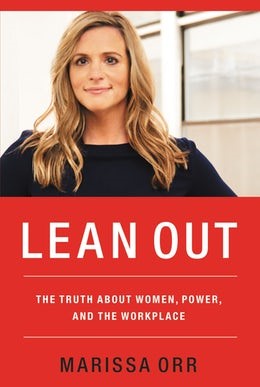Let’s get this out of the way: Yes, Marissa Orr’s Lean Out: The Truth About Women, Power, and the Workplace is something of a response to Facebook COO Sheryl Sandberg’s hugely popular and influential Lean In: Women, Work, and the Will to Lead. “[The title is] obviously a little provocative,” Orr said in an interview with HSMAI, “but at the same time it really captures the essence of the book, which is a counterargument for Lean In.

Orr’s goal is to help women succeed in the corporate world. But while Sandberg advocates in Lean In for women to empower themselves at work by adopting and embracing the same behaviors as men, Orr thinks it’s not that simple. “Our systems of organizing employees, evaluating performance, and motivating people were built by men, from a male worldview, with the intention of making male employees more productive,” Orr writes in Lean Out. “They were built to serve an economy that’s long gone. While the whole world, the entire fabric of our economy, and the composition of our workforce have transformed since then, our systems have remained almost exactly the same.”
Lean Out grew out of a lecture series on women and work that Orr created when she was at Google as an alternative to the company’s female leadership programs, which she thought “lacked a realness and an honesty.” The series quickly grew in popularity, but she put it aside when she moved to Facebook, only to revisit the whole issue after her experience at the social-media giant went sideways, which she documents with hilarious, painful honesty in Lean Out. “I thought, I think we’re getting something wrong here, and in pursuit of closing the gender gap, we’re undermining a lot about women without realizing it,” Orr told HSMAI, “so I wrote my own perspective on the topic.”
You’re very nuanced in Lean Out in how you talk about gender stereotypes. You acknowledge that they exist and that there is some truth to them, but you also push back on them.
Books like Lean In and modern feminism and conventional wisdom all tend to blame the gender gap on stereotypes and culture, the theory being that women are punished for violating gender norms of this female stereotype of nurturer and caregiver. And because they’re penalized for that, they start to mute their ambition over time. They don’t want to be CEO because they’ve been punished for being too bossy. That’s the thesis underneath what is called in Lean In the “leadership ambition gap.”
As someone who conforms to a lot of aspects of a female stereotype, like being nurturing and compassionate — I’m very communal and a why-can’t-we-all-just-get-along kind of person — those are the things that really hurt me in the workplace. And it was the women who acted outside the lines, who were very aggressive and pushy, they were the ones always getting promoted. So, part of the genesis of Lean Out was seeing that my day-to-day experiences at work didn’t intersect with these theories. It didn’t make sense to me.
There’s some fascinating research out there that shows that there are these certain behaviors — there is a category called agreeableness in the Big Five personality traits, and there’s a lot that is correlated with the female stereotype. Agreeable people are nice and warm and likable and friendly; the higher you score on the dimension of agreeableness, the lower your chances are for ascending the ladder. And this aggressive, dominant kind of personality under the umbrella of extroversion, which is the fifth one of the Big Five categories — that is the predictor of who will rise to the top. The higher you score on desire for dominance predicts how high you’ll go.
At work, it’s not even about gender, it’s about these categories. Men who score high on agreeableness are punished the worst. They’re punished for being agreeable, because those behaviors don’t get you to the top, and then they’re penalized a second time for violating a male stereotype. So, to me, the leadership ambition gap — this theory that women don’t get to the top because they’re punished for violating gender norms — didn’t make sense. It doesn’t dovetail with the research.
On top of that, there’s a trade-off on both sides. When women act aggressive and bossy and violate the female gender norm, they are less likable. That is true. That’s a big thing in Lean In, and there are all these studies that show that when men act aggressive and dominant, they’re liked more by both genders, but when women do it, they’re liked less. And that is true, but being likable is actually a disadvantage in getting ahead. For me, I’m highly agreeable, so I had a lot of friends. I was very likable. But my trade-off was people didn’t respect me as much.
The point is, yes, stereotypes exist. Yes, there are penalties. And that’s unfortunate, because really the message of the book is: Be who you are and own it. If you want to be the CEO of a multinational conglomerate and you’re a woman, go for it. More power to you. If you want to stay at a mid-level management position because you would get more balance and flexibility, great. Own it. There’s a limit that stereotypes have in terms of their effect on women at work. It’s not the cause of the gender gap, and we’re so relentlessly focused on that piece of it when that’s not really the problem.
What is the problem? What is causing the gender gap?
There are several things, but we focus on what women need to do to change their behavior in order to get to the top. And in Lean Out, I make the argument that women are not the cause nor the solution to the gender gap. The gender gap is a result of a dysfunctional system and structure, which is the corporate hierarchy. It’s a zero-sum game for power and dominance that was created by men in the industrial age. Men are more motivated by competition, but women prefer and perform better and are motivated by collaborative win-win scenarios. So right off the bat, the system is biased toward the part of the population that is competitive.
And two, most large organizations have so many people around doing so many different things, it’s hard to tell who’s doing a good job. Sometimes you don’t even know who’s doing any work at all. And we’re a knowledge economy now, so the output of so much of our work is invisible. It’s hard to measure. In these environments that lack clarity and that are highly ambiguous, our brains default to whatever is most visible, so those behaviors like aggression and self-promotion, talking about your work, working on the biggest project, these are the proxies we use for performance. And these proxies, these behaviors, correlate more highly with men, but they don’t correlate more highly with competence.
In the past 300 years, the entire economy has transformed and the composition of the workforce has transformed, but these underlying structures have remained exactly the same. What makes more sense — rewiring women to conform to an outdated system, or rewiring a system to better meet the needs of a more diverse workforce?
Where do you even start when the problem is a gigantic, seemingly intractable system?
You can change the rules of the game, or you can change how you play it. A lot of women are not in a position to change the rules — they’re somewhere in the middle of the corporate hierarchy — but they can change the way they play it. And that’s all about defining success on your own terms.
But to answer your question more specifically from a systems point of view, about two or three months ago, I was in Austin for work and my friend Julie came and met me. She had just read Lean Out. I met Julie when I first started working at Google, but she left many years ago and she and her husband run a bakery now in Madison, Wisconsin. She said that before she read the book, she had been struggling with how to handle a situation at work. This woman Mariella, who was a baker, was amazing. She was the best one they had. They wanted to give her a promotion, but the only spot that was above her was head baker. When you’re head bakery, you have to do a lot of operational stuff and management takes you away from baking.
But this guy Mark that also works for her wanted to be head baker, and he would be good at it. The problem was, Julie felt he wouldn’t respect Mariella because she would report to him and she wouldn’t have as much influence, and she didn’t know how to reward Mariella in the absence of a promotion. Then she read my book and she said, “Mariella doesn’t want to be head baker, but why am I structuring my business like this? I’m structuring things the only way I know. I was thinking inside the lines.” She said, “What we ended up doing was, we promoted Mariella, so now she reports to me, and Mark is head baker, and he reports to me. So now they are of equal influence. He has to respect her, because she’s equal in decision making, but she gets to bake and do what she loves. She makes more money, she has more benefits, and she has more influence and impact.”
A lot of it is rethinking how are we motivating people and rewarding people. We’re just so stuck in this structural mindset of a hierarchy.
What can employers do to help make that vision a reality?
I think a very basic step is for organizations to really understand what it is that will reward and motivate women to want to make a bigger impact on the organization. In a lot of cases, that doesn’t look like a management position, so it’s up to the organization to figure out what that looks like. I can’t tell people how to run their business, but the core principle is pretty universal: People only work hard for things that they want. A promotion comes with, yes, some more money, which a lot of us want, but also more management responsibilities and more face time, which compromise the balance and flexibility that a lot of women really crave.
It’s also the idea that making the most impact doesn’t mean managing the most people. I wanted to work on bigger, more complex, unsolvable problems, but because of my level and because I couldn’t get advanced because I didn’t want to be a manager, I was not allowed to do that. And it was a shame, because I could have made such a bigger impact at Google had I been allowed to widen that circle of impact without managing people.
